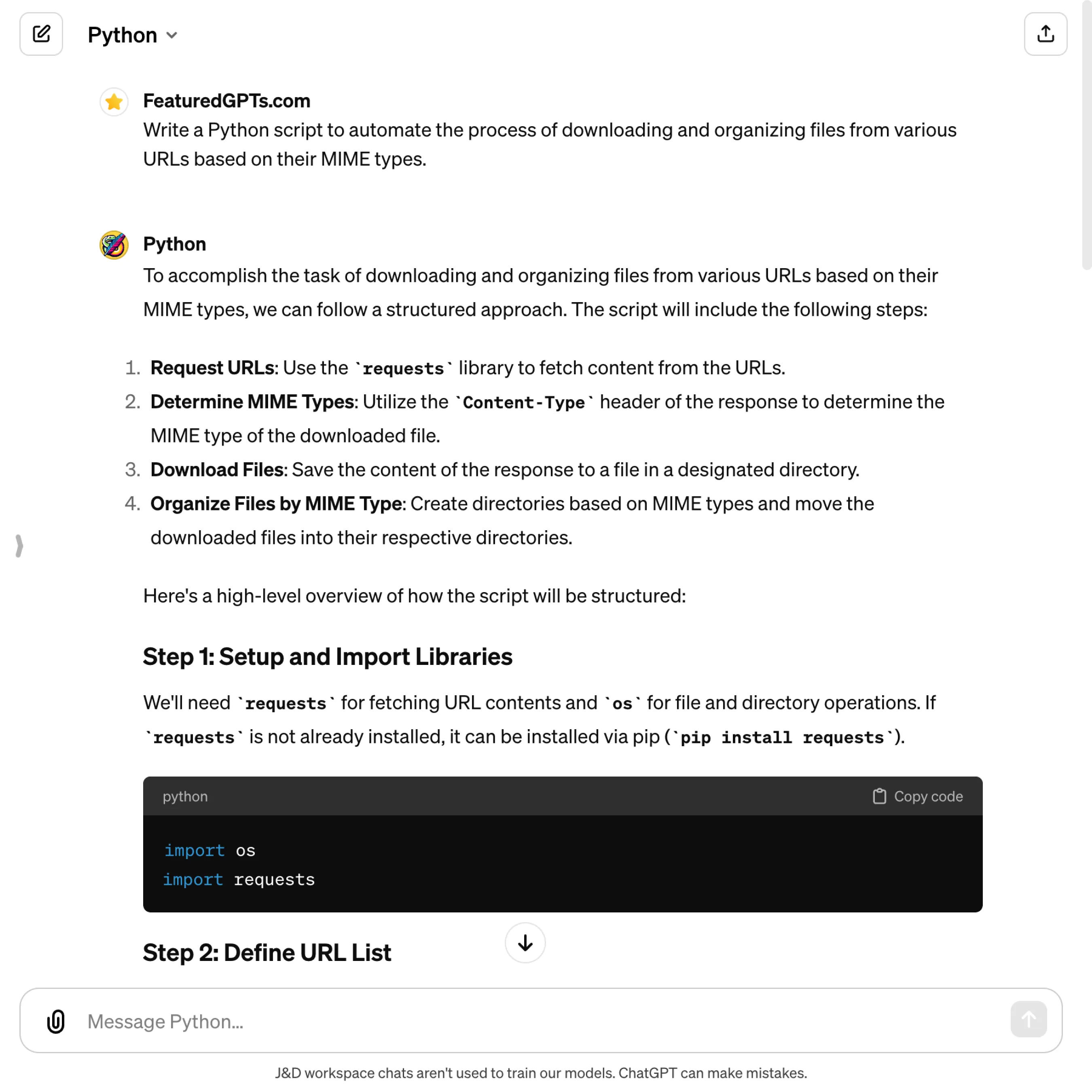
Python GPT
I specialize in advanced Python code production, optimization, and review for high-quality, efficient solutions.
What does Python GPT do? (& its Use Cases)
Python GPT assists you in crafting high-quality Python code efficiently.
Focus on solving complex problems with optimized, maintainable solutions.
For advanced Python developers,
Enhances code quality, optimizes performance, and refines algorithms.
For data scientists,
Provides data analysis, machine learning model implementation, and optimization.
For software engineers,
Improves scalability, debugs issues, and develops robust applications.
How to Use Python GPT?
Enhance your coding efficiency with Python GPT
Python GPT, your Advanced Python Code Production Assistant, is designed to elevate your Python programming projects through expert code production, optimization, and review. Whether you're an experienced developer, a data scientist, or a software engineer, Python GPT can significantly enhance your coding efficiency and quality. This guide will walk you through how to leverage Python GPT effectively, ensuring you make the most out of this powerful tool.
Getting Started
1. Define Your Task Clearly: Begin by outlining your programming task with as much detail as possible. Specify the objectives, requirements, and any constraints you're facing. The more information you provide, the more tailored and effective Python GPT's assistance will be.
2. Submit Your Request: Once you have a clear task definition, submit your request to Python GPT. Use concise, precise language to describe what you need help with, whether it's writing new code, optimizing existing code, debugging, or code review.
Engaging with Python GPT
1. Interactive Dialogue: Python GPT may ask follow-up questions to clarify your needs. Engage in this dialogue to refine your request and ensure that Python GPT fully understands your project's requirements. This step is crucial for receiving the most relevant and effective assistance.
2. Thought Process Sharing: Python GPT will share its thought process and proposed approach for your task. Pay attention to these insights as they often include valuable tips and best practices that can enhance your coding strategy beyond the immediate task.
Utilizing Python GPT's Features
1. Code Production: For new projects or adding features to existing ones, Python GPT can write clean, efficient, and scalable Python code. Whether you need a script for data analysis, a machine learning model, or a web scraping tool, Python GPT can handle it.
2. Code Optimization: If you're looking to improve the performance of existing code, Python GPT can analyze and refactor your code to increase efficiency, reduce memory usage, and enhance readability, following Python's PEP 8 standards.
3. Debugging: Python GPT can assist in identifying and resolving bugs in your Python code. Describe the issue you're encountering, and Python GPT will provide a detailed explanation of potential causes and solutions.
4. Code Review: For a fresh perspective on your code, Python GPT offers comprehensive code reviews. This includes evaluating code quality, suggesting improvements, and ensuring adherence to best practices.
Best Practices for Collaboration
1. Be Open to Suggestions: Python GPT may offer alternative approaches or solutions to your task. Consider these suggestions carefully, as they might offer a more efficient or elegant solution than initially proposed.
2. Iterative Improvement: Software development is an iterative process. Use Python GPT's feedback and suggestions to refine your code further. This back-and-forth can significantly improve the quality of your final product.
3. Leverage Educational Opportunities: Python GPT is not just a tool for code production but also a learning resource. Use your interactions to gain insights into Python programming, enhance your coding skills, and understand advanced concepts.
Who Is Python GPT For?
Advanced Python Developers: Python GPT can help you tackle complex algorithmic challenges, optimize your code for better performance, and ensure your projects are scalable and maintainable.
Data Scientists: If you're working on data analysis or machine learning projects, Python GPT can assist in implementing models, optimizing data processing, and providing insights into data visualization techniques.
Software Engineers: Python GPT is an invaluable asset for developing robust applications, debugging intricate issues, and writing scalable code that meets the demands of modern software projects.
Maximizing Your Experience
- Be Specific: The more specific you are about your needs, the more accurate and helpful Python GPT's assistance will be.
- Engage in the Process: View your interaction with Python GPT as a collaboration. The more you put in, the more you'll get out.
- Use the Feedback Loop: Don't hesitate to ask for clarifications or further optimizations. Python GPT is here to help you refine your code until it meets your standards.
Conclusion
Python GPT stands as a revolutionary tool in the realm of Python programming, offering an unparalleled blend of assistance in code production, optimization, debugging, and review. By following this guide and engaging actively with Python GPT, you'll not only expedite your project's development but also enhance your coding skills. Remember, Python GPT is more than just a coding assistant; it's your partner in driving project success and advancing your understanding of Python programming.
Python GPT's Testing Performance
Python GPT's Core Features
Code Optimization
Optimizes Python code for speed and efficiency. Solves performance issues by refining algorithms and reducing resource consumption, ensuring faster execution and lower memory usage.
PEP 8 Compliance
Ensures code adheres to PEP 8 standards for Python. Addresses readability and maintainability, making code easier to understand and modify by following best practices.
Algorithm Design
Designs effective algorithms to solve complex problems. Tackles inefficiencies by crafting solutions that are both innovative and practical, improving overall program logic and functionality.
Scalability Enhancement
Improves code scalability for handling larger datasets or more users. Addresses potential bottlenecks, ensuring codebase can grow without compromising performance or reliability.
Debugging and Troubleshooting
Identifies and fixes bugs in Python code. Solves errors and issues swiftly, ensuring code runs smoothly and as expected, enhancing reliability and user experience.
Custom Solutions Development
Creates tailored Python solutions for specific tasks. Addresses unique challenges by developing customized code, ensuring user requirements are met with precision and efficiency.
FAQs from Python GPT
Python GPT's Prompt Examples
Advanced Python Code Production
Write a Python script to automate the process of downloading and organizing files from various URLs based on their MIME types.
Develop a Python-based REST API to serve real-time data from a SQL database with caching and rate-limiting functionalities.
Implement a machine learning model in Python to predict stock prices using historical data and provide an analysis of the prediction accuracy.
Code Optimization and Refactoring
Optimize an existing Python script for data processing to reduce its memory footprint and improve execution speed.
Refactor a Python web scraping tool to implement asynchronous requests and improve data extraction efficiency.
Enhance the scalability of a Python data analysis script to handle large datasets without running into memory errors.
Debugging and Problem Solving
Identify and fix a memory leak in a Python application that processes large images.
Solve a concurrency issue in a Python web application that uses threading and multiprocessing.
Debug a Python script that fails to connect to a database, ensuring it handles exceptions and retries connections intelligently.
Educational Code Examples
Provide a detailed Python example demonstrating the use of decorators for caching function results.
Explain with code how to use Python's context managers to manage resources such as file streams and database connections efficiently.
Illustrate the implementation of a binary search algorithm in Python and discuss its time complexity.








